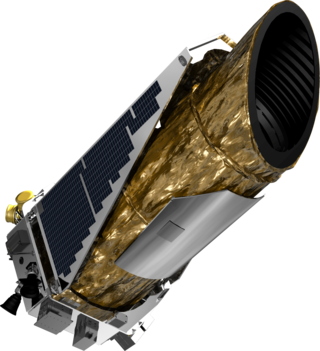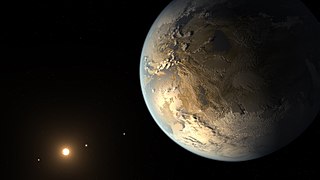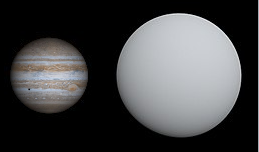
In astronomy, a light curve is a graph of the light intensity of a celestial object or region as a function of time, typically with the magnitude of light received on the y-axis and with time on the x-axis. The light is usually in a particular frequency interval or band.

In astronomy, a transit is the passage of a celestial body directly between a larger body and the observer. As viewed from a particular vantage point, the transiting body appears to move across the face of the larger body, covering a small portion of it.

The Kepler space telescope is a defunct space telescope launched by NASA in 2009 to discover Earth-sized planets orbiting other stars. Named after astronomer Johannes Kepler, the spacecraft was launched into an Earth-trailing heliocentric orbit. The principal investigator was William J. Borucki. After nine and a half years of operation, the telescope's reaction control system fuel was depleted, and NASA announced its retirement on October 30, 2018.

An exomoon or extrasolar moon is a natural satellite that orbits an exoplanet or other non-stellar extrasolar body.

These are lists of exoplanets. As of 10 January 2024, there are 5,569 confirmed exoplanets in 4,142 planetary systems, with 942 systems having more than one planet. Most of these were discovered by the Kepler space telescope. There are an additional 1,984 potential exoplanets from Kepler's first mission yet to be confirmed, as well as 977 from its "Second Light" mission and 4,584 from the Transiting Exoplanet Survey Satellite (TESS) mission.

TrES-2b (Kepler-1b) is an extrasolar planet orbiting the star GSC 03549-02811 located 750 light years away from the Solar System. The planet was identified in 2011 as the darkest known exoplanet, reflecting less than 1% of any light that hits it. Reflecting less light than charcoal, on the surface the planet is said to be pitch black. The planet's mass and radius indicate that it is a gas giant with a bulk composition similar to that of Jupiter. Unlike Jupiter, but similar to many planets detected around other stars, TrES-2b is located very close to its star and belongs to the class of planets known as hot Jupiters. This system was within the field of view of the Kepler spacecraft.

Any planet is an extremely faint light source compared to its parent star. For example, a star like the Sun is about a billion times as bright as the reflected light from any of the planets orbiting it. In addition to the intrinsic difficulty of detecting such a faint light source, the light from the parent star causes a glare that washes it out. For those reasons, very few of the exoplanets reported as of January 2024 have been observed directly, with even fewer being resolved from their host star.

The NASA Exoplanet Science Institute (NExScI) is part of the Infrared Processing and Analysis Center (IPAC) and is on the campus of the California Institute of Technology (Caltech) in Pasadena, CA. NExScI was formerly known as the Michelson Science Center and before that as the Interferometry Science Center. It was renamed NExScI in the Fall of 2008 to reflect NASA's growing interest in the search for planets outside of the Solar System, also known as exoplanets. The executive director of NExScI is Charles A. Beichman.
A Kepler object of interest (KOI) is a star observed by the Kepler space telescope that is suspected of hosting one or more transiting planets. KOIs come from a master list of 150,000 stars, which itself is generated from the Kepler Input Catalog (KIC). A KOI shows a periodic dimming, indicative of an unseen planet passing between the star and Earth, eclipsing part of the star. However, such an observed dimming is not a guarantee of a transiting planet, because other astronomical objects—such as an eclipsing binary in the background—can mimic a transit signal. For this reason, the majority of KOIs are as yet not confirmed transiting planet systems.
The NASA Star and Exoplanet Database (NStED) is an on-line astronomical stellar and exoplanet catalog and data service that collates and cross-correlates astronomical data and information on exoplanets and their host stars. NStED is dedicated to collecting and serving important public data sets involved in the search for and characterization of exoplanets and their host stars. The data include stellar parameters, exoplanet parameters and discovery/characterization data.

Planet Hunters is a citizen science project to find exoplanets using human eyes. It does this by having users analyze data from the NASA Kepler space telescope and the NASA Transiting Exoplanet Survey Satellite. It was launched by a team led by Debra Fischer at Yale University, as part of the Zooniverse project.
Kepler-80, also known as KOI-500, is a red dwarf star of the spectral type M0V. This stellar classification places Kepler-80 among the very common, cool, class M stars that are still within their main evolutionary stage, known as the main sequence. Kepler-80, like other red dwarf stars, is smaller than the Sun, and it has both radius, mass, temperatures, and luminosity lower than that of our own star. Kepler-80 is found approximately 1,223 light years from the Solar System, in the stellar constellation Cygnus, also known as the Swan.

Kepler-69c is a confirmed super-Earth extrasolar planet, likely rocky, orbiting the Sun-like star Kepler-69, the outermore of two such planets discovered by NASA's Kepler spacecraft. It is located about 2,430 light-years from Earth.

NGTS-3Ab is a gas giant exoplanet that orbits a G-type star. Its mass is 2.38 Jupiters, it takes 1.7 days to complete one orbit of its star, and is 0.023 AU from its star. Its discovery was announced in 2018. The Jupiter-like planet is discovered by 39 astronomers, mainly Max Günther, Didier Queloz, Edward Gillen, Laetitia Delrez, and Francois Bouchy.
TOI-700 is a red dwarf 101.4 light-years away from Earth located in the Dorado constellation that hosts TOI-700 d, the first Earth-sized exoplanet in the habitable zone discovered by the Transiting Exoplanet Survey Satellite (TESS).
KOI-5 is a triple star system composed of three stars: KOI-5 A, KOI-5 B and KOI-5 C, orbiting 1,870±70 light-years away.

BD+60 1417b is a confirmed exoplanet discovered in the year 2021 using the imaging method. BD+60 1417b is the only known exoplanet in the system BD+60 1417, around 45 parsecs from Earth. BD+60 1417 is a young K0 star, while BD+60 1417 b has a late-L spectral type. The planet might be the first discovery of a directly imaged exoplanet found by a citizen scientist. Discovery of exoplanets involving amateurs are usually transiting exoplanets and are rarely discovered with other methods. Another example of a non-transiting exoplanet discovery by an amateur is the microlensing exoplanet Kojima-1Lb.
Kepler-385 is an F-type main-sequence star located about 4,900 light-years away from Earth in the constellation of Cygnus. The star is 10% larger and 5% hotter than the Sun. The star has at least three, and potentially up to seven, exoplanets discovered orbiting it.














